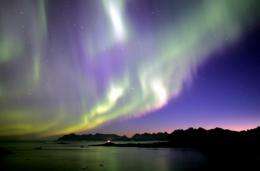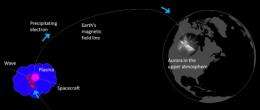Researchers examine why some aurora displays flicker in the night sky

Look up into the night sky in Alaska, Northern Canada, or Russia just before dawn, and you may able to make out a faint whitish glow of the northern lights. Watch for a few minutes, and the lights will blink on and off as if someone is flipping a light switch.
It's a pulsating aurora, a variety of northern lights that flickers every 5 to 40 seconds. Scientists have searched for the driver behind this flickering light show for decades.
Now UCLA's Yukitoshi Nishimura, NASA scientists, five spacecraft, and a small army of high-resolution cameras keeping an eye on the night sky have discovered the answer: electromagnetic energy that sings in the Earth's magnetic field.
The Earth is like a giant magnet. Invisible magnetic lines stretch from one end of the globe to the other -- they're what causes a compass needle to move and helps migrating birds find their way.
This magnetic field also protects life on Earth from the solar wind, a stream of particles spat out by the sun that continually bombards the planet. These solar particles are swept away from our planet's surface by the Earth's magnetic field, creating bursts of electromagnetic energy called chorus or whistler waves -- so named because they change pitch over time.
"Back in World War I, people communicating with walkie-talkies would every once in a while hear whistler-mode waves created by lightning," said team member Larry Lyon of UCLA. "A chorus wave chirps like a bird if you play it through a speaker."
Nishimura and NASA's THEMIS team discovered that these chorus waves appear at regular intervals in the same locations as the patches of light. The stronger the waves, the brighter the light.

Their theoretical calculations showed that chorus waves are able to interact with electrons in the Earth's magnetic field, knocking them downwards into the atmosphere and creating the pulsating aurora's light show much in the same way that a cathode ray tube created images on the screens of older model televisions.
The team's findings, published Oct. 1 in the journal Science, could also help scientists to map the Earth's magnetic field in greater detail -- by continuing to track the dancing of auroral lights and the music of chorus waves behind them.
More information: Identifying the Driver of Pulsating Aurora, Science 1 October 2010: Vol. 330. no. 6000, pp. 81 - 84. DOI:10.1126/science.1193186
Provided by Inside Science News Service


















